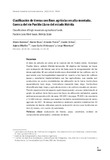Mostrar el registro sencillo del ítem
Clasificación de tierras con fines agrícolas en alta montaña. Cuenca del río Pueblo Llano del estado Mérida
| dc.rights.license | http://creativecommons.org/licenses/by-nc-sa/3.0/ve/ | |
| dc.contributor.author | Ramírez, Alexis | |
| dc.contributor.author | Rivas, Dante | |
| dc.contributor.author | Flores R., Ernesto J. | |
| dc.contributor.author | Ochoa, Guido | |
| dc.contributor.author | Oballos Salas, Jajaira | |
| dc.contributor.author | Velásquez Monsalve, Juan Carlos | |
| dc.contributor.author | Manrique Viana, Jorge Ali | |
| dc.date.accessioned | 2011-06-22T19:50:21Z | |
| dc.date.available | 2011-06-22T19:50:21Z | |
| dc.date.issued | 2011-06-22T19:50:21Z | |
| dc.identifier.issn | 0798-2437 | es_VE |
| dc.identifier.uri | http://www.saber.ula.ve/handle/123456789/33370 | |
| dc.description.abstract | El área de estudio se ubica en la cuenca del río Pueblo Llano, municipio Pueblo Llano, estado Mérida-Venezuela. El objetivo del trabajo es hacer una evaluación de tierras que sirva de base para la reorganización de las áreas agrícolas. El uso actual revela poca diversidad en los cultivos, por lo que existe una homogeneidad espacial en cuanto a los tipos de cultivos (papa y zanahoria) implementados por los agricultores. Los cuales son producidos en cuatro modalidades de utilización de la tierra: horticultura especializada bajo riego, horticultura mejorada bajo riego, horticultura diversificada bajo riego y agricultura mixta o de cultivos anuales en secano. Para la organización de espacio agrícola propuesto, una vez determinado el grado de aptitud de la tierra para los tipos de utilización señalados, puede estimarse una producción de unas 100.000 t de papa, 75.000 t de zanahoria y 14.000 t de ajo, valores que superan los datos suministrados por el censo agrícola de 2001. El ensayo estadístico realizado permitió sintetizar las 30 unidades de tierras utilizadas para la evaluación de los usos hortícolas en dos (2) clases, con cuatro (4) subclases. | es_VE |
| dc.language.iso | es | es_VE |
| dc.rights | info:eu-repo/semantics/openAccess | |
| dc.subject | Evaluación de tierras | es_VE |
| dc.subject | Papa | es_VE |
| dc.subject | Zanahoria | es_VE |
| dc.subject | Análisis de componentes principales | es_VE |
| dc.subject | Unidades de tierra | es_VE |
| dc.title | Clasificación de tierras con fines agrícolas en alta montaña. Cuenca del río Pueblo Llano del estado Mérida | es_VE |
| dc.title.alternative | Classification of high mountain agricultural lands. Pueblo Llano River basin, Mérida State | es_VE |
| dc.type | info:eu-repo/semantics/article | |
| dc.description.abstract1 | The study area is located in the Pueblo Llano River basin, Pueblo Llano Municipality, Mérida State, Venezuela. The aim of this paper is to make an assessment of lands that works as a basis for the reorganization of agricultural areas. The current use shows little crop diversity, so that there is spatial homogeneity with respect to the types of crops (potatoes, carrots) implemented by the farmers. These crops are produced in four modalities of land use: under irrigation specialized horticulture, under irrigation improved horticulture, under irrigation diversified horticulture and combined food and energy farming or annual dry farming. For the organization of the proposed agricultural space, once the degree of aptitude for the types of use above mentioned is determined, a 100,000 t of potato, 75,000 t of carrot and 14,000 t of garlic harvest can be estimated; these values could exceed the data supplied by the 2001 agriculture census. The statistical essay permitted to synthesize the 30 used land units to assess the horticultural uses in two (2) classes and four (4) sub-classes. | es_VE |
| dc.description.colacion | 9-32 | es_VE |
| dc.description.email | guidooch@ula.ve | es_VE |
| dc.description.email | oballos@ula.ve | es_VE |
| dc.description.email | jcvelasq@ula.ve | es_VE |
| dc.description.email | jmanriqu@ula.ve | es_VE |
| dc.description.frecuencia | semestral | es_VE |
| dc.identifier.depositolegal | 198102ME433 | es_VE |
| dc.subject.facultad | Facultad de Ciencias Forestales y Ambientales | es_VE |
| dc.subject.institutoinvestigacion | Instituto Forestal LatinoAmericano (IFLA) | es_VE |
| dc.subject.keywords | Land assessment | es_VE |
| dc.subject.keywords | Potatoes | es_VE |
| dc.subject.keywords | Carrots | es_VE |
| dc.subject.keywords | Main component analysis | es_VE |
| dc.subject.keywords | Land units | es_VE |
| dc.subject.publicacionelectronica | Revista Forestal Latinoamericana | es_VE |
| dc.subject.seccion | Revista Forestal Latinoamericana: Artículos | es_VE |
| dc.subject.thematiccategory | Geografía | es_VE |
| dc.subject.thematiccategory | Medio Ambiente | es_VE |
| dc.subject.tipo | Revistas | es_VE |
| dc.type.media | Texto | es_VE |
Ficheros en el ítem
Este ítem aparece en la(s) siguiente(s) colección(ones)
-
Revista Forestal Latinoamericana - Vol 023 (2) - Nº 44
Julio - Diciembre 2008


